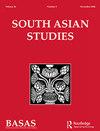The Impact of Akhlaq-i Nasiri on the Forms and Spaces of Akbar’s Fatehpur Sikri
IF 0.7
0 ASIAN STUDIES
引用次数: 0
Abstract
In this article, I examine the structures and spatial dynamics of Fatehpur Sikri to show how the overall design of the Mughal capital city was informed by Islamic philosophy and ethical texts known as akhlaq. Both discourses used the concept of the city to theorize how the ideals of justice could be materialized. After creating an interpretative framework based on these texts, I focus on four spaces of interaction at Fatehpur Sikri, the Jami Masjid, Diwan-i Aam, Ibadat Khana, and markets, to show how the phenomenology of Peripatetic Islamic philosophy, later translated for Mongol kings by Nasir al-Din Tusi (1201–74), influenced the meaning of the city. Through this investigation, I argue that Fatehpur Sikri was a means of bringing the ethical concepts of Persianate philosophy to life in sixteenth-century Mughal India and introducing a new set of social and religious norms to the people.Akhlaq-i Nasiri对阿克巴《法塔赫布尔·西克里》形式和空间的影响
在这篇文章中,我研究了Fatehpur Sikri的结构和空间动态,以展示莫卧儿首都的整体设计是如何受到伊斯兰哲学和伦理文本akhlaq的影响的。两篇论述都使用了城市的概念来理论化正义的理想是如何实现的。在基于这些文本创建了一个解释框架之后,我将重点放在Fatehpur Sikri、Jami Masjid、Diwan-i Aam、Ibadat Khana和市场的四个互动空间上,以展示后来由Nasir al-Din Tusi(1201-74)为蒙古国王翻译的伊斯兰哲学的现象学如何影响城市的意义。通过这一调查,我认为Fatehpur Sikri是将波斯哲学的伦理概念带入16世纪莫卧儿王朝印度的一种手段,并向人们介绍了一套新的社会和宗教规范。
本文章由计算机程序翻译,如有差异,请以英文原文为准。
求助全文
约1分钟内获得全文
求助全文

 求助内容:
求助内容: 应助结果提醒方式:
应助结果提醒方式:


